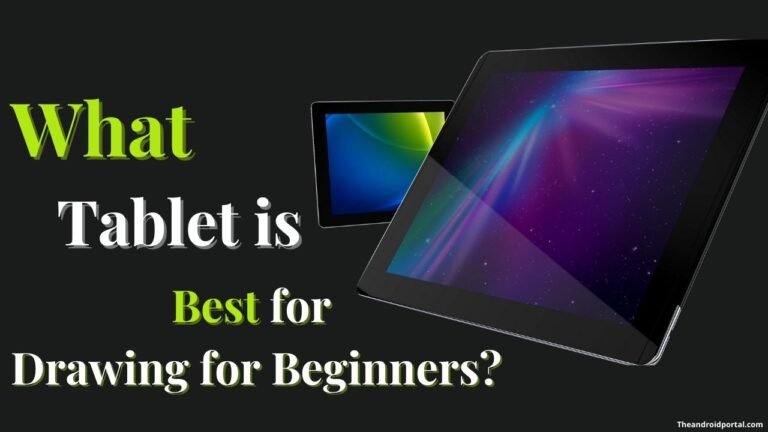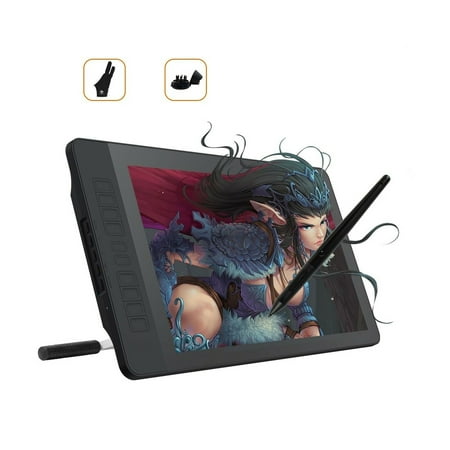
The digital art world is full of drawing tablets of all different shapes, sizes, and brands. It comes with a battery-free pen that never needs to be recharged. It can be connected to your tablet via Bluetooth.
And the medium-sized drawing area offers enough room for a beginner. But this best graphic tablet for beginners is my recommendation based on my personal experience.

If you want to buy a different tablet or a cheaper option, this guide will help. I will cover the best drawing tablets for beginners just getting into digital art. There’s always a learning curve from traditional to digital, so you’ll want to ensure that any graphics tablet you get is something you’ll love.
What Is The Best Graphic Tablet For Beginners?

What Makes A Tablet Great?
If you are new to buying graphic tablets, you will probably need clarification on all the features. But it’s not too hard to know; the more you investigate, the more you learn.

There are two main types of tablets: with a screen and without a screen. Display tablets display a screen on your device, and you draw directly on the screen.
Screenless drawing tablets are more “traditional” when you draw on a black surface while staring at the monitor. The strokes are recorded on the tablet and then translated into your software (Photoshop, Krita, PaintTool SAI).
Most beginners should start with screenless tablets because they are cheaper. Sure, drawing on a tablet with a screen is considerably easier, but there is always a learning curve, so start small. However, there are several common characteristics to look for:
Wacom is an obvious starting place because industry professionals use its tables worldwide. However, it performs admirably on tablets made by other firms such as XP-Pen, Huion, Ugee, or Parblo (among others). The idea is to find the qualities you require at a price that fits your budget.
Do you want a large-screen tablet, or are you OK with a smaller tablet? Do you specifically want a tablet with a screen? Or are you willing to spend a little more for higher quality? Also, remember that smaller tablets are easier to carry in a laptop bag if you want to draw/paint from your laptop digitally.
Some smaller tablets can be powered via USB, while others require a power outlet. It’s important to keep all of these features in mind when reviewing this list.
Find What You Need
These graphics tablets can work if you’re a beginner with little or no digital experience. But what you need may depend on the space on your desk and how long your tablet will last. If you are OK with buying a new tablet in 1-2 years, you can get by with a cheaper option for now.
However, if you want a tablet that will last you 5-6 years, if not a decade, a higher-end brand like Wacom is your best bet. I have made this list with all the different artists in mind. I know some readers are newer artists still practising their fundamentals, trying to go digital. Other readers are artists with years of experience as traditional artists who want to do more digital work.
And many readers may be in the middle, just trying to immerse themselves in digital drawing/painting. Price and usability are the two most crucial factors to consider.
You’ll need to spend more money if you want a tablet with a screen. You have many more options if you want a portable tablet. Either way, explore this list and see what you think. If any tablet catches your eye, be sure to bookmark it for later.
Best Graphic Tablet For Beginners
Wacom One HD Creative Pen Display, Drawing Tablet
The Wacom Intuos Pro Large Bluetooth graphics drawing tablet is the perfect device for anyone looking to take their creative projects to the next level. This graphics tablet comes with an ultra-responsive Wacom Pro Pen 2, which gives you the familiar feeling you are used to with exceptional sensitivity.
It also features a compact Bluetooth design, touch gestures, and programmable buttons, giving you a wide range of options to personalize your work and create.
The compact design of this product, along with its 8 Express Keys Touch Ring and pen side switches, gives you a broad range of ways to personalize your work. You can set up shortcuts on the Touch Ring, so they’re easy to reach whenever you need them most.
Pros
- Good value for money
- Large active area
- 8,000+ pressure sensitivity levels
- Good palm rejection
Cons
- The pen stand doesn’t grip well
XP-Pen Artist Display 24 Pro
The XPPen Artist 24 Pro is a drawing tablet with plenty of space for creativity. It has a huge 23.8-inch display with a 2K resolution (2560 x 1440). Artist 24 Pro tablet produces realistic and vivid colours, allowing you to craft with incredible depth and detail.
The Artist 24 Pro offers a USB-C to USB-C connection, so you can connect your iMac, Mac Book Pro, or Windows computer without needing an adapter. It also includes an adjustable stand, so you can change the angle of the product to suit your needs.
The XPPen Artist Display 24 Pro features a comfortable grip and two easy-to-operate red dial wheels that allow you to operate your device easily. This tablet has 20 programmable shortcut keys on each side for convenient access while using the device.
Pros
- Large, colour-accurate 2K display
- Excellent drawing/writing accuracy
- 20 customizable shortcut keys, two dial wheels
- Affordable price
Cons
- Heavy
HUION Inspiroy H430P OSU
The Huion H430P OSU graphic drawing tablet is a powerful and durable device used for various tasks, including drawing, trading, writing, photo editing, and graphic design. The tablet’s main functions are drawing and writing, photo editing, graphic design, etc.
The tablet has an active area of 4.8 x 3 inches (123 x 76 mm). The device has a resolution of 800 x 600 dpi with 10 points of pressure sensitivity on the screen. It is compatible with Linux (Ubuntu), macOS 10.11 and above, Windows 7, and Android 6.0. It connects to your PC or laptop via a USB cable and is suitable for left- and right-handed users.
The tablet pen is battery-free; no need to be charged or replaceable cartridges or nibs are included. The device comes with four replacement nibs: black ink pen nibs (including 0.7mm medium tip) and black gel pen nibs (including 1mm thick gel tip).
See also: Top rated Tablets with replaceable batteries
Pros
- Very affordable
- It has four customizable keys
- The stylus does not require a battery
Cons
- It uses a cable connection
Gaomon PD1560
GAOMON PD1560 is the latest professional drawing tablet with IPS Full HD 1920*1080 resolution and is easy to set up. PD1560 has a 15.6-inch drawing area and provides a display with a 178° viewing angle.
With 8192 levels of pressure, it offers more accurate and responsive pen-cursor movement to make your drawing line smoother and more natural than ever before.
It also has 10 shortcut keys and 5 menu keys for your customized shortcuts to work more efficiently and save precious time. In addition, the ergonomic design allows for an adjustable stand with a cable protector so that the signal cable does not fall easily during the moving process and a carrying handle for portability.
Pros
- Big, bright, beautiful display
- Active pen with great pressure accuracy
- Tons of functional buttons
Cons
- It doesn’t work with ChromeOS
Wacom – Cintiq 16 Creative Pen
Bring the creative pen experience to your Mac or PC with the Wacom Cintiq 16 creative pen display drawing tablet. The large 15.6 IPS LCD allows you to create directly on screen with a natural pen experience and full HD 1920 x 1080 resolution.
The tablet is perfect for painting, retouching, and page layout work due to its high colour accuracy, 25ms response time, and 210 cd/m2 brightness.
The Cintiq 16 creative pen tablet is fully compatible with various creative software, including Adobe Photoshop, Illustrator, Lightroom, Corel Painter, and Manga Studio 5 EX.
It comes with Clip Studio Paint EX with a 3-in-1 interface cable that connects to your computer via USB and HDMI. A bonus software pack offers 6 months of Clip Studio Paint EX.
Pros
- Low latency
- Includes Clip Studio Paint Pro
- Two sizes
Cons
- Reports of bad screens
Types of Drawing Tablets
Screenless Tablets: The Minimalist’s Dream
First up, we have screenless tablets. Picture this: a sleek, flat surface that connects to your computer. You draw on it, and voila, your masterpiece appears on the monitor. It’s like a magic carpet for your digital art.
Screenless tablets offer a tactile experience similar to traditional drawing, minus the mess of ink and paper.
Pros
- Affordability: Your wallet will thank you.
- Portability: Easy to carry, making it perfect for on-the-go artists.
Cons
- Learning Curve: It might take a minute to get used to looking at one screen while drawing on another.
Display Tablets: See What You Draw
Next in line are display tablets. Imagine a tablet that doubles as a second monitor. You draw directly on the screen, making the process incredibly intuitive. It’s like having a sketchbook that comes alive.
Pros
- Real-Time Feedback: You see your strokes as you make them.
- High Resolution: These tablets often come with stunning displays.
Cons
- Price Tag: Prepare to invest a bit more in this piece of tech.
Combination Tablets: Best of Both Worlds
Last but not least, let’s talk about combination tablets. These bad boys can switch between screenless and display modes. It’s like having your cake and eating it too, but in tablet form.
Pros
- Versatility: Use it as a screenless or display tablet based on your needs.
- Space-saving: One device for multiple functions.
Cons
- Complexity: More features mean more things that could go wrong.
So, there you have it, folks. Whether you’re a minimalist who loves the straightforwardness of screenless tablets, a visual artist craving the immediacy of display tablets, or a versatile genius who wants it all with combination tablets, there’s something out there for you.
How to Choose the Best Drawing Tablet for Your Needs: A Comprehensive Guide
Navigating the labyrinthine world of drawing tablets can be a daunting endeavour, especially for those just dipping their toes into the digital art realm. The market is saturated with options, each boasting an array of features that cater to different artistic needs and preferences.

So, how does one sift through the noise to find the tablet that aligns with their unique requirements? Allow me to elucidate.
Define Your Artistic Objectives
The initial step in this journey involves a thorough self-assessment of your artistic goals. Are you an aspiring animator, a digital illustrator, or perhaps a graphic designer? The nature of your work will significantly influence your choice of tablet.
For rudimentary sketching or doodling, a screenless tablet may suffice. However, intricate digital painting or 3D modelling often demands the advanced capabilities of a high-end display tablet.
Financial Constraints: A Pragmatic Approach
Budgetary considerations are an inescapable aspect of any purchasing decision. Drawing tablets span a broad financial spectrum, with screenless options generally falling on the more economical end.
Display tablets and combination tablets, replete with advanced features, naturally command a higher price point. Establish a budget that aligns with your financial constraints but doesn’t compromise on essential features.
Portability: A Key Consideration for the Modern Artist
In today’s fast-paced world, the ability to create on the move is not just a luxury but often a necessity. If your artistic endeavours frequently take you beyond the confines of a studio, opt for a tablet that prioritizes portability.
Compact dimensions and lightweight construction should be high on your list of criteria. Conversely, if your work is primarily stationary, a larger tablet with an expansive drawing area may be more suitable.
Compatibility: The Linchpin of Seamless Functionality
Before committing, ensure that the tablet is compatible with your existing hardware and software ecosystem. Compatibility extends beyond mere connectivity; it also encompasses the tablet’s ability to function seamlessly with your preferred design software.
The last thing you need is a tablet that’s ostensibly perfect but fundamentally incompatible with your setup.
Hands-On Experience: An Invaluable Asset
Whenever possible, take the tablet for a test drive. Many retailers offer display models that allow you to experience the tablet’s tactile response, pressure sensitivity, and overall ergonomics.
This hands-on interaction can provide invaluable insights that no amount of online research can replicate.
Conclusion
In conclusion, there are many great drawing tablets available on the market, but some of the best options for beginners include the Wacom One by Wacom, the XP-Pen Artist 12, the Huion Inspiroy H640P, and the Gaomon PD1560. These tablets offer a good balance of features, performance, and price, making them ideal for beginners who are just getting started with digital art.
When choosing a drawing tablet, it is important to consider your budget, experience level, and desired features. If you are on a tight budget, the Wacom One or the Huion Inspiroy H640P are good options. If you are looking for a tablet with a larger drawing area or a display, the XP-Pen Artist 12 or the Gaomon PD1560 are good choices.
Once you have chosen a drawing tablet, be sure to read the instructions carefully and practice using it before you start working on any important projects. There are also many online tutorials and resources available to help you learn how to use a drawing tablet effectively.






![Best Drawing Tablets for Beginners 7 Simbans PicassoTab Drawing Tablet No Computer Needed [4 Bonus Items] Drawing Apps, Stylus Pen, Portable, Standalone, 10 Inch Screen, Best Gift for Beginner Digital Graphic Artist -PCX](https://m.media-amazon.com/images/I/51zLm+fHzpL._SL500_.jpg)





